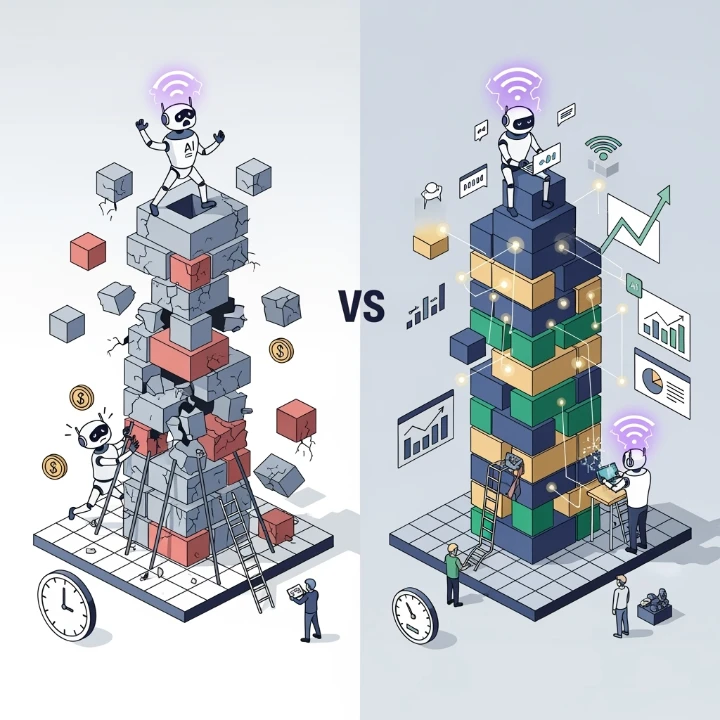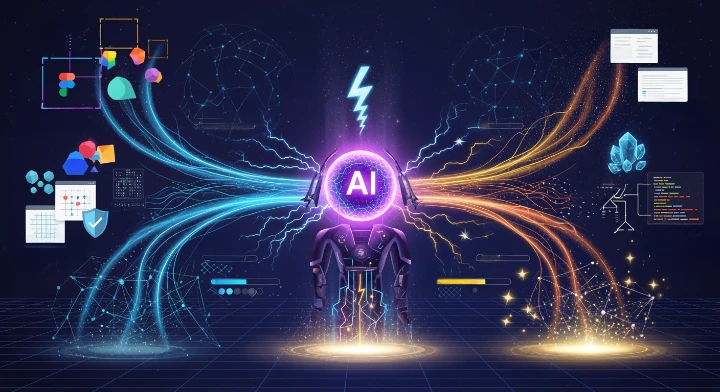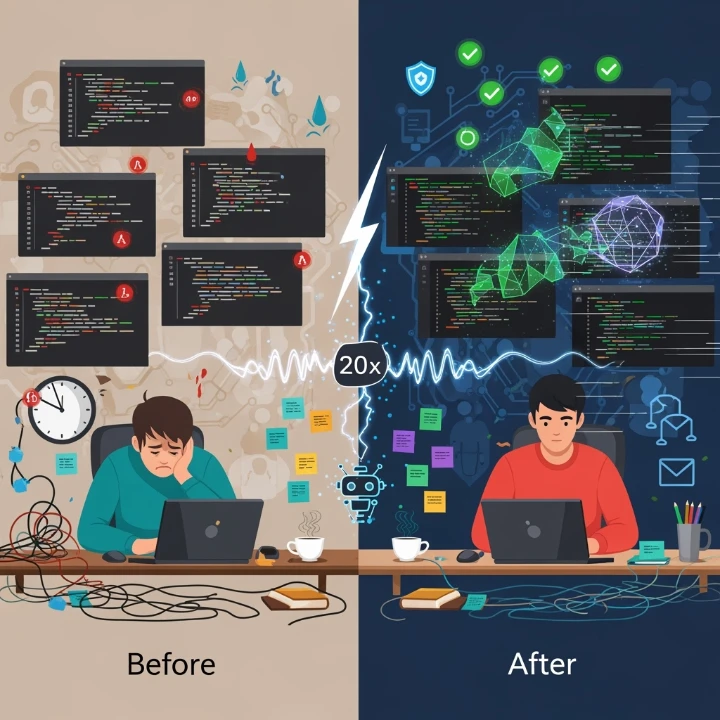Are you a frontend developer struggling to keep up with project demands? AI coding assistants can boost your productivity by 26-57% according to recent enterprise studies, but most developers use them wrong and end up with buggy, insecure code. This guide shows you exactly how top developers achieve 10-20x speed increases while maintaining code quality, with specific strategies for frontend development and actionable implementation steps you can start using today.
The difference between developers seeing massive gains versus those disappointed with AI tools comes down to workflow integration, not tool selection.
The current state: what’s actually working in 2025
The AI coding landscape has matured beyond simple autocomplete suggestions. Several distinct approaches have emerged, each optimised for different development workflows. Cursor integrates deeply with VS Code's ecosystem, offering sophisticated predictive editing that anticipates multi-line changes. Claude Code takes a different approach, excelling at visual development and architectural discussions through its artifact system and extended context handling, while Google's latest models demonstrate the potential of massive context windows exceeding 1M tokens. Meanwhile, open-source solutions like Zed and Cline provide developers with full control over their AI workflows without vendor lock-in.
Here’s what the data reveals about AI coding performance:
- Developers assisted by GitHub Copilot finished a coding task 55% faster, with a higher overall success rate (78% versus 70%) (GitHub Developer Survey 2024)
- GitHub Copilot is already writing 46% of code and helps developers code up to 55% faster
- According to GitHub’s June 2023 survey, 92% of surveyed U.S.-based developers report using AI coding tools in and out of work
- 69% of developers have tried, and 49% regularly use ChatGPT for coding and other development-related activities jetbrains survey
- 40% of AI-generated code contains security vulnerabilities (Georgetown CSET study)
These are results from 2024 or even older, so I expect even more usage of AI and a bigger % of AI-written code.
What works best right now
Excellent AI use cases:
- Boilerplate generation and code transformation
- Test suite creation from existing patterns
- Documentation and commenting
- Refactoring and pattern implementation
- Component scaffolding in React/TypeScript
Poor AI use cases:
- Complex system architecture decisions
- Distributed system debugging
- Business logic requiring domain knowledge
- Security-critical authentication flows
The foundation: why your starting patterns matter more than your tools

The biggest mistake developers make is jumping into AI without establishing solid patterns first. The code patterns you create early will be amplified by AI across your entire codebase. Poor initial patterns become exponentially harder to refactor later.
The real cost of AI refactoring
Here’s a sobering reality check: Refactoring AI-generated code is expensive. I recently spent $70 refactoring a very small project I've built from scratch with Claude Code - money that could have been saved with better upfront planning. When AI replicates poor patterns across dozens of components, the cost to fix them multiplies quickly.
But cost isn’t the only issue - big refactoring is a bug-prone process. The refactoring introduced many new bugs that took additional time to identify and fix, further increasing the total cost and timeline.
Why AI refactoring costs more:
- AI generates code faster than humans can review it thoroughly
- Poor patterns get replicated across multiple files simultaneously
- AI-generated code often has subtle interconnections that break during refactoring
- You’re essentially paying for AI to undo what AI created
- Refactoring introduces new bugs that require additional debugging time
The lesson: invest time in architecture planning upfront rather than paying for expensive fixes later.
Building your AI-ready codebase
Before introducing AI, establish:
Clean Architecture Foundations:
- Consistent naming conventions across components
- Clear separation between UI, business logic, and data layers
- Proper TypeScript configurations with strict mode enabled
- Atomic design principles with dedicated folders for components, hooks, types, and utilities
React & TypeScript: AI strategies that actually work
The CO-STAR prompting framework for components
Instead of vague requests like “create a form,” use structured prompts:
- Context: “In a Next.js 15 app with TypeScript and Tailwind”
- Objective: “Generate a user registration form component”
- Style: “Following our existing form patterns with React Hook Form”
- Tone: “Include comprehensive TypeScript interfaces and error handling”
- Audience: “Senior developers familiar with our codebase conventions”
- Response: “Create components, types, and tests”
Advanced AI Workflow: From 1x to 20x Speed
The developers, seeing massive productivity gains, follow this pattern:
- Scaffold with AI: Generate initial component structure
- Iterate with AI: Refine and customize through conversation
- Test with AI: Generate comprehensive test suites
- Review with AI: Catch issues and enforce coding standards
This creates a feedback loop where AI understands your patterns and improves over time.
Security: Why most AI-generated code contains vulnerabilities

Georgetown’s Center for Security and Emerging Technology research shows that nearly half of AI-generated code contains vulnerabilities. Here’s your defense strategy:
Essential security practices
Automated Security Scanning:
- SonarQube or CodeQL on all AI outputs
- Snyk for dependency vulnerability scanning
- Qodo and CodeRabbit for AI-specific security analysis
- Integrate these tools in your CI/CD pipeline for automated checks
- Mandatory human review for authentication and data handling
Common AI Security Mistakes:
- SQL injection vulnerabilities
- XSS attack vectors
- Hardcoded credentials
- Improper input validation
- Missing authentication checks
Feature flags: your safety net for AI-generated features
With AI enabling rapid feature development, you need robust testing and rollout mechanisms. The speed of AI development requires safety nets that traditional development doesn’t need.
Recommended feature flag platforms
GrowthBook - Analytics-driven experimentation
- Built-in A/B testing capabilities
- Real-time analytics integration
- Advanced targeting and segmentation
Unleash - Enterprise-grade feature management
- Robust API and SDK ecosystem
- Advanced user targeting
- Comprehensive audit trails
Flagsmith - Open-source flexibility
- Self-hosted options available
- Strong developer experience
- Cost-effective for smaller teams
MCP Integration: Giving AI Superpowers

Model Context Protocol (MCP) connectors provide AI with a comprehensive understanding of your development ecosystem:
Context7 - Up-to-date documentation for LLMs and AI code editors
- Up-to-date, version-specific documentation
- Real, working code examples from the source
- Concise, relevant information with no filler
- Free for personal use
- Integration with your MCP server and tools
Figma Integration - Design-to-code workflows
- Generate components from design files
- Maintain design system consistency
Playwright Integration - Automated testing
- Get visual (or ARIA snapshots) feedback for the model
- Generate tests from user interactions
- Maintain comprehensive test coverage
- Catch regressions in AI-generated code
Code quality: the iterative improvement strategy
Rather than overwhelming AI with comprehensive style guides upfront, introduce guidelines iteratively:
The mistake-driven approach
- Identify patterns: Notice when AI makes the same mistake repeatedly
- Document solutions: Create specific rules and prompts to prevent the pattern
- Refine guidelines: Update your AI instructions based on actual behavior
- Share knowledge: Distribute successful patterns across your team
Example: common AI mistakes and fixes
Problem: AI generates overly permissive TypeScript types Solution: Add this to your prompts: “Use strict TypeScript with no ‘any’ types. Prefer union types and proper generic constraints.”
Problem: AI creates an inconsistent component structure
Solution: Provide component templates: “Follow this exact component structure with props interface, default export, and named export for types.”
Multi-tool strategy and parallel development (the 20x promise)
Consider running tools in parallel for different use cases rather than seeking one perfect solution. Also, it can speed up the development because multiple instances of Claude Code/Codex/etc can work on different problems at the same time.
Advanced technique: Use git worktrees for parallel AI instances. You can run multiple agentic editors or CLI tools simultaneously on different branches using git worktree, allowing you to experiment with different AI approaches without conflicts:
# Create separate worktrees for different AI experiments
git worktree add ../project-cursor cursor-experiments
git worktree add ../project-claude claude-experiments
# Work with different AI tools in parallel
cd ../project-cursor # Use Cursor here
cd ../project-claude # Use Claude Code here
The Future: Preparing for AI-First Development
By 2026, development will shift from writing code to orchestrating AI agents. Organisations preparing for this transition focus on:
- Preserving human expertise in architecture and design decisions
- Building AI orchestration skills rather than just AI assistance
- Maintaining code quality standards as AI capabilities expand
- Developing domain expertise that AI cannot replicate
The key challenge remains the context problem - AI’s limited understanding of broader system architecture and business requirements. Tools solving this through persistent context and team knowledge integration will dominate.
Getting started now
The developers achieving 20x productivity gains aren't waiting for perfect tools or comprehensive guidelines. They're starting with solid foundations, implementing safety nets, and iterating rapidly based on real-world results.
Your next steps:
Start with the right template - Use the frontend-vibe-code-template for React/TypeScript projects. This modern starter template is specifically built for AI-assisted development with:
- Pre-configured code quality checks (Biome and Ultracite for linting and formatting)
- MCP server integration for Claude Code: Playwright, Context7, and Figma
- Automated testing setup with Vitest, Storybook, and Chromatic
- Feature-first architecture that AI tools understand well
- Git hooks integration
Set up your AI development environment - Use the template from GitHub or clone it
git clone https://github.com/olhapi/frontend-vibe-code-template.git my-project cd my-project npm install cp .env.example .env # Add your API keys to .env source .env && claude # Start Claude Code with MCP serversImplement feature flags and testing - The template includes testing infrastructure; add feature flags using the platforms mentioned above that will suit your project needs
Follow the template's AI guidelines - Reference
CLAUDE.mdfor project-specific AI prompting patterns that work with this structureUse the feature-first approach - Create features in
src/features/with self-contained components, stories, and testsLet automation handle quality - Git hooks automatically format, lint, and update documentation on every commit + CI that run tests and storybook snapshots
Remember: AI amplifies your existing patterns. Starting with a well-structured template ensures that AI generates high-quality code from day one. The template's built-in quality gates and testing infrastructure provide the safety nets you need for rapid AI-assisted development.
The future belongs to developers who master AI orchestration while maintaining strong technical fundamentals.
